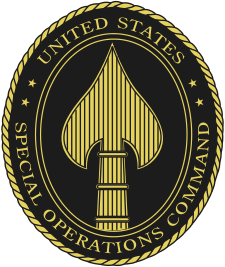United States Army Special Operations Command
| United States Army Special Operations Command (Airborne) | |
|---|---|
|
Army Special Operations Command Emblem | |
| Active | 1 December 1989 – present[1] |
| Country |
|
| Allegiance | Constitution of the United States |
| Branch |
|
| Type | Special Operations |
| Role | Organize, train, educate, man, equip, fund, administer, mobilize, deploy and sustain Army special operations forces to successfully conduct worldwide special operations |
| Size |
33,805 personnel authorized:[2]
|
| Part of |
|
| Garrison/HQ | Fort Bragg, North Carolina |
| Motto(s) | "Sine Pari" (Without Equal) |
| Engagements |
Operation Just Cause Operation Enduring Freedom Operation Iraqi Freedom |
| Website | Official Website |
| Commanders | |
| Current commander | LTG Kenneth E. Tovo[1] |
| Insignia | |
| Distinctive Unit Insignia[3] Unit Flash |
 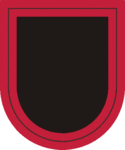 |
The United States Army Special Operations Command (Airborne) (USASOC) is the command charged with overseeing the various special operations forces of the United States Army. Headquartered at Fort Bragg, NC, it is the largest component of the United States Special Operations Command. Its mission is to organize, train, educate, man, equip, fund, administer, mobilize, deploy and sustain Army special operations forces to successfully conduct worldwide special operations.
Subordinate units
U.S. Army 1st Special Forces Command (Airborne) (Provisional)

Established in 1952, the U.S. Army Special Forces Command (Airborne), also known as the Green Berets, was established as a special operations force of the United States Army tasked with five primary missions: unconventional warfare, foreign internal defense, special reconnaissance, direct action, and counter-terrorism. These missions make special forces unique in the U.S. military, because they are employed throughout the three stages of the operational continuum: peacetime, conflict and war.[4]
Today's Special Forces Groups and their unconventional warfare capabilities provide a viable military option for a variety of operational taskings that are inappropriate or infeasible for conventional forces, making it the U.S. military’s premier unconventional warfare force.[4]
Often SF units are required to perform additional, or collateral, activities outside their primary missions. These collateral activities are coalition warfare/support, combat search and rescue, security assistance, peacekeeping, humanitarian assistance, humanitarian de-mining and counter-drug operations.[4]
In 2016, the 1st Special Forces Command (Airborne) (Provisional) manages seven Special Forces Groups (SFGs) (five active duty and two national guard), two Military Information Support Groups (MISG), one Civil Affairs Brigade, and one Sustainment Brigade.[5]
4th and 8th Military Information Support Groups (Airborne)
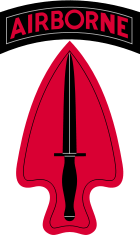
The mission of the 4th and 8th Military Information Support Groups (MISGs) Psychological Operations (PSYOP) units is to provide fully capable strategic influence forces to Combatant Commanders, U.S. Ambassadors, and other agencies to synchronize plans and execute inform and influence activities (IIA) across the range of military operations.[5][6]
Psychological Operations is a part of the broad range of U.S. political, military, economic and ideological activities used by the U.S. government to secure national objectives. Used during peacetime, contingencies and declared war these activities are not forms of force, but are force multipliers that use nonviolent means in often violent environments. Persuading rather than compelling physically, they rely on logic, fear, desire or other mental factors to promote specific emotions, attitudes or behaviors.[6]
The ultimate objective of U.S. PSYOP is to convince enemy, neutral, and friendly nations and forces to take action favorable to the United States and its allies. The ranks of the PSYOP include regional experts and linguists who understand political, cultural, ethnic and religious subtleties and use persuasion to influence perceptions and encourage desired behavior. With functional experts in all aspects of tactical communications, PSYOP offers joint force commanders unmatched abilities to influence target audiences as well as strategic influence capabilities to U.S. diplomacy.[6]
In addition to supporting commanders, PSYOP units provide interagency strategic influence capabilities to other U.S. government agencies. In operations ranging from humanitarian assistance to drug interdiction, PSYOP enhances the impact of those agencies’ actions. Their activities can be used to spread information about ongoing programs and to gain support from the local populace.[6]
95th Civil Affairs Brigade (Airborne)
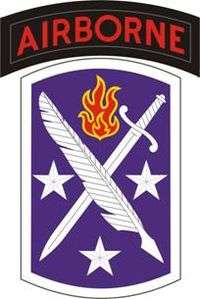
The 95th Civil Affairs Brigade (Airborne) enable military commanders and U.S. Ambassadors to improve relationships with various stakeholders in a local area to meet the objectives of the U.S. government. 95th Civil Affairs Brigade (Airborne) teams work with U.S. Department of State country teams, government and nongovernmental organizations at all levels and with local populations in peaceful, contingency and hostile environments. 95th Civil Affairs Brigade (Airborne) units can rapidly deploy to remote areas with small villages, as well as to larger population centers around the world.[7]
They help host nations assess the needs of an area, bring together local and non-local resources to ensure long-term stability, and ultimately degrade and defeat violent extremist organizations and their ideologies. They may be involved in disaster prevention, management, and recovery, and with human and civil infrastructure assistance programs.[7]
95th Civil Affairs Brigade (Airborne) soldiers are soldiers first, but are adept at working in foreign environments and conversing in one of about 20 foreign languages with local stakeholders. Brigade teams may work for months or years in remote areas of a host nation. Their low profile and command structure allow them to solidify key relationships and processes, to address root causes of instability that adversely affect the strategic interests of the United States.[7]
528th Sustainment Brigade (Airborne)
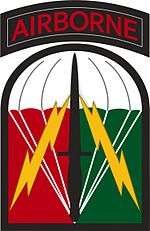
The 528th Sustainment Brigade (Airborne) is responsible for providing logistical, medical and signal support for Army special operations forces worldwide in support of contingency missions and war fighting commanders.[8]
Headquartered at Fort Bragg, North Carolina, the 528th Sustainment Brigade (Airborne) sets the operational level logistics conditions to enable Army Special Operation Forces (ARSOF) operations worldwide using three ARSOF Support Operations Teams (ASPOs), three Special Operations Resuscitation Teams (SORT), five ARSOF Liaison Elements (ALE), two Medical Level II teams and 112th Special Operations Signal Battalion (Airborne). Together the units of the brigade ensure that U.S. Army Special Operations Forces are equipped to perform their missions.[8]
The brigade has the capability of providing technical control to multiple Special Forces group support battalions in the planning and execution of ARSOF combat service support and combat health support. The 528th Sustainment Brigade (Airborne) is capable of deploying three Army Support Operations Teams in support of three ARSOF-based Special Operations Task Forces or a SOF-based JTF. The Support Operations Team initially co-locates with the group support battalion or a Ranger support operations detachment and provides ARSOF with an in-theater presence providing centralized and integrated material management of property, equipment maintenance, logistical automation and repair parts and supplies.[8]
ARSOF Liaison Elements soldiers are embedded in Army regional theaters’ staff. They plan and coordinate with theater Army, Special Operations Command and Army Special Operations Command to ensure support during operations and training. As a theater Army staff member, these officers and non-commissioned officers’ knowledge of theater-specific requirements and capabilities assist units in coordination with the theater.[8]
The medical section provides Level II medical support as USASOC asset managed by the brigade surgeon and constitutes the nucleus of the capability of receiving a conventional Army Forward Surgical Team. The medical section is robust enough to provide combat health support on an area basis for approximately 450 personnel. The support includes unit-level medical support and health services, logistics, emergency medical and resuscitative treatment for all classes of patients; emergency dental treatment, physical therapy and preventive medicine support, while maintaining Standard Army Management Information Systems and providing veterinary support.[8][9]
Members of the 112th Special Operations Signal Battalion (Airborne) specialize in communication and force sustainment skills, employing innovative telecommunications technologies to provide Army Special Operations Task Force commanders with secure and nonsecure voice, data and video services. In their respective fields, signal and support soldiers provide oversight of material distribution management, synchronization, and integrated material management of property accountability, maintenance management and logistics automation for deployed ARSOF. Communications expertise allows ARSOF to "shoot, move and communicate" on a continuous basis. Soldiers assigned to ARSOF units are taught to operate and maintain a vast array of unique equipment not normally used by their conventional counterparts. To meet the needs of ARSOF, the Sustainment Brigade has developed logistical and signal packages that are rapidly deployable on a moment’s notice. Soldiers assigned to these units are airborne qualified.[8]
The 528th Sustainment Brigade embodies its motto of "We Support to the Utmost," providing the means to effectively and efficiently execute logistics in support of ARSOF operations.[8]
U.S. Army Special Operations Aviation Command
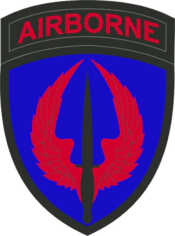
The U.S. Army Special Operations Aviation Command (USASOAC), activated on 25 March 2011, organizes, mans, trains, resources and equips Army special operations aviation units to provide responsive, special operations aviation support to Special Operations Forces (SOF) and is the USASOC aviation staff proponent.[10]
During the past decade of persistent engagement by SOF, USASOC aviation experts recognized a need for separating the combat role of Army SOF aviation from the resourcing responsibilities. This structure provides the appropriate command and control, manning and visibility for the complex and sensitive tasks required of Army SOF aviation units and organizations. ARSOAC is a one-star, subordinate command to USASOC.[10]
The 160th Special Operations Aviation Regiment (Airborne), ["Death Waits In The Dark"] newly subordinate to ARSOAC,[11] provides aviation support to special operations forces. Known as Night Stalkers, these soldiers are recognized for their proficiency in nighttime operations. Soldiers of the 160th pioneered the Army’s nighttime flying techniques. The unit became known as the Night Stalkers because of its capability to strike undetected during the hours of darkness and its unprecedented combat successes. Today, Night Stalkers continue to develop and employ new technology and tactics, techniques and procedures for the battlefield. They employ highly modified Chinook, Black Hawk and assault and attack configurations of Little Bird helicopters.[12]
The 160th SOAR(A) is composed of a regiment headquarters, four battalions and a dedicated training company. The regiment headquarters is collocated with the 1st and 2nd Battalions and the Special Operations Aviation Training Company at Fort Campbell, Kentucky; 3rd Battalion is located at Hunter Army Airfield, Georgia; and 4th Battalion is located at Fort Lewis, Washington. This strategic organizational structure postures the regiment to support special operations forces mission and training requirements well into the future.[12] NSDQ - "Night Stalkers Don't Quit"
Soldiers of the 160th have been actively and continuously engaged in the combat operations since October 2001. Today, the 160th Special Operations Aviation Regiment (Airborne) continues a sustained and active forward presence in the U.S. Central Command area of operations at multiple locations in support of operations Enduring Freedom. Crews also provide support to U.S. Southern, Pacific, Africa, and European commands.[12]
75th Ranger Regiment

The 75th Ranger Regiment, also known as the Rangers, is a light infantry special operations force. The regiment is headquartered at Fort Benning, Georgia and is composed of one special troops battalion and three light infantry special operations battalions with specialized skills that enable them to perform a variety of special operations missions.
The 75th Ranger Regiment is capable of executing myriad complex, joint special operations missions in support of U.S. policy and objectives. Their capabilities include air assault and direct action raids seizing key terrain such as airfields, and destroying strategic facilities. Rangers are capable of conducting squad through regimental size operations using a variety of infiltration techniques including airborne, air assault and ground platforms. The regiment is an all-volunteer force with an intensive screening and selection process followed by combat-focused training. Rangers are resourced to maintain exceptional proficiency, experience and readiness.[13]
U.S. Army John F. Kennedy Special Warfare Center and School

The U.S. Army John F. Kennedy Special Warfare Center and School (SWCS) at Fort Bragg, North Carolina, is one of the Army's premier education institutions, managing and resourcing professional growth for soldiers in the Army's three distinct special-operations branches: Special Forces, Civil Affairs and Psychological Operations. The soldiers educated through SWCS programs are using cultural expertise and unconventional techniques to serve their country in far-flung areas across the globe. More than anything, these soldiers bring integrity, adaptability and regional expertise to their assignments.[14]
On any given day, approximately 3,100 students are enrolled in SWCS training programs. Courses range from entry-level training to advanced warfighter skills for seasoned officers and NCOs. The 1st Special Warfare Training Group (Airborne) qualifies soldiers to enter the special-operations community, and teaches them advanced tactical skills as they progress through their careers. The Joint Special Operations Medical Training Center, operating under the auspices of the Special Warfare Medical Group, is the central training facility for Department of Defense special-operations combat medics. Furthermore, SWCS leads efforts to professionalize the Army's entire special-operations force through the Special Forces Warrant Officer Institute and the David K. Thuma Noncommissioned Officer Academy. While most courses are conducted at Fort Bragg, SWCS enhances its training by maintaining facilities, and relationships with outside institutions, across the country.[14]
List of commanders
- LTG Peter Schoomaker, October 1996 – 1997[15]
- LTG William Tangney, 1997 – 11 October 2000
- LTG Bryan D. Brown, 11 October 2000 – 29 August 2002
- LTG Philip R. Kensinger, Jr., 29 August 2002 – 8 December 2005
- LTG Robert W. Wagner, 8 December 2005 – 7 November 2008
- LTG John F. Mulholland, Jr., 7 November 2008 – 24 July 2012[16]
- LTG Charles T. Cleveland, 24 July 2012 – 1 July 2015
- LTG Kenneth E. Tovo, 1 July 2015 – present[17]
References
- 1 2 SOCOM Fact Book 2014 (PDF). SOCOM Public Affairs. 2014. Retrieved 2015-12-17.
- ↑ http://www.gao.gov/assets/680/671462.pdf
- ↑
- 1 2 3 U.S. Army Special Forces Command. Soc.mil. Retrieved 2015-12-17.
- 1 2 USASOC Headquarters Fact Sheet, from the USASOC official website, last accessed 8 October 2016
- 1 2 3 4 "MISOC Units Re-designate as PSYOP – ShadowSpear Special Operations". Shadowspear.com. 2015-12-13. Retrieved 2015-12-17.
- 1 2 3 95th Civil Affairs Brigade. Soc.mil. Retrieved 2015-12-17.
- 1 2 3 4 5 6 7 528th Sustainment Brigade. Soc.mil. Retrieved 2015-12-17.
- ↑ Jamie Riesberg (2009). "The Special Operations Resuscitation Team: Robust Role II Medical Support for Today's SOF Environment" (PDF). Journal of Special Operations Medicine. 9. Retrieved 2014-01-26.
- 1 2 Archived 14 October 2013 at the Wayback Machine.
- ↑ "Night Stalkers mark new lineage with donning of USASOAC patch | Article | The United States Army". Army.mil. 2013-10-03. Retrieved 2015-12-17.
- 1 2 3 160th SOAR(A) Overview. Soc.mil. Retrieved 2015-12-17.
- ↑ 75th ranger Regiment. Soc.mil. Retrieved 2015-12-17.
- 1 2 About SWCS. Soc.mil. Retrieved 2015-12-17.
- ↑ "Peter Jan Schoomaker". History.army.mil. Retrieved 2015-12-17.
- ↑
- ↑ "USASOC welcomes Tovo as Commanding General". Army.mil. 2 July 2015l. Retrieved 2015-12-17.
External links
| Wikimedia Commons has media related to United States Army Special Operations Command. |
